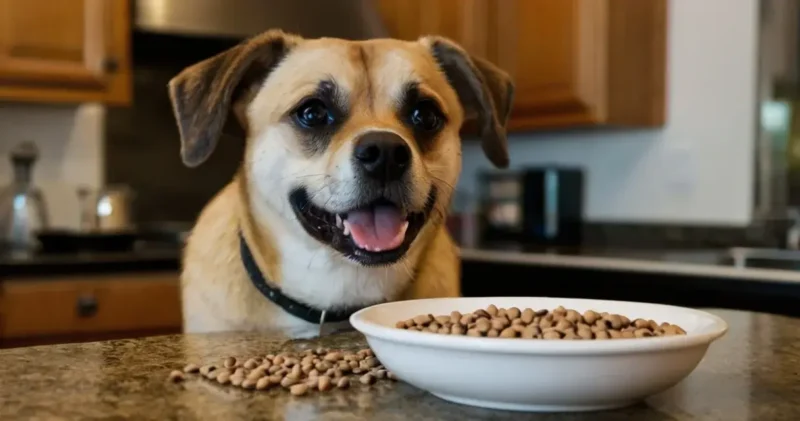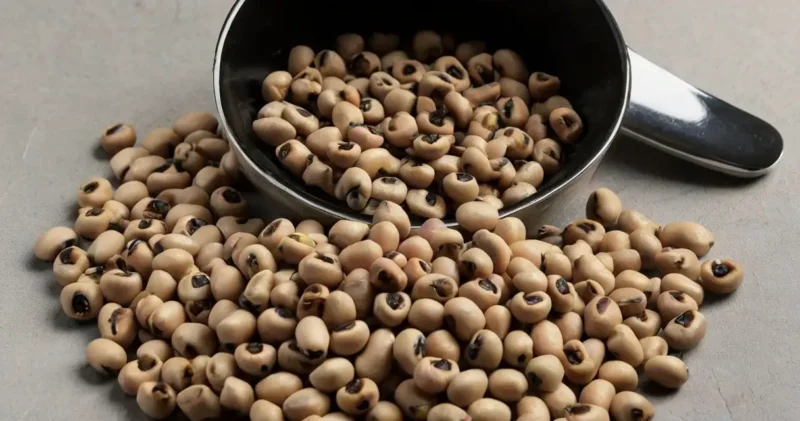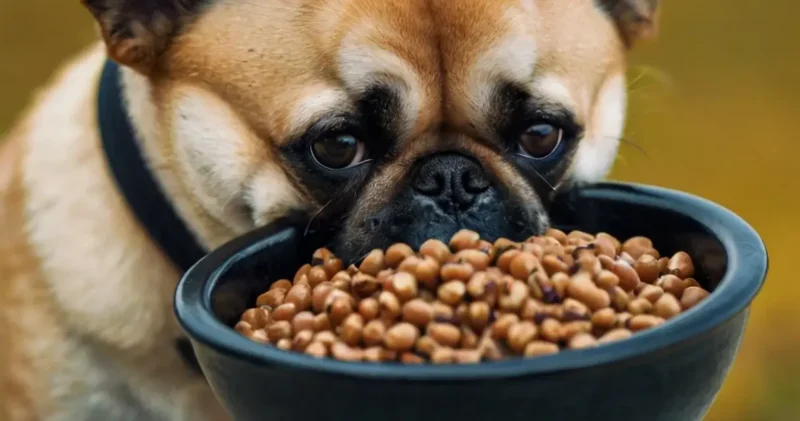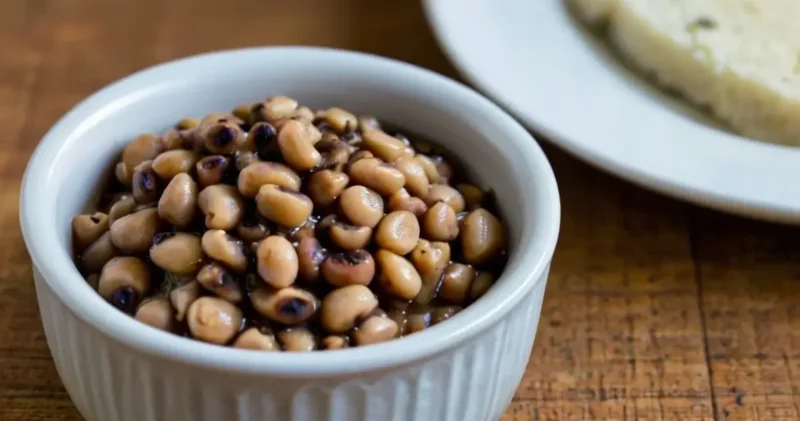
Did you know that black-eyed peas are not actually peas, but rather beans? They belong to the legume family and are also known as cowpeas. These small, creamy beans are packed with nutrients like folate, potassium, and iron, making them a healthy addition to human diets worldwide.
When it comes to our furry friends, a very common question I encounter is, “Can dogs eat black-eyed peas?” Based on numerous surveys and research, in my opinion, dogs can indeed eat black-eyed peas but only in moderation. Feeding your dog a moderate amount of black-eyed peas can offer a number of health benefits. However, if you overlook the quantity and allow your hungry dog to consume as much as he wants, it might be harmful.
To explore more, let’s get into this article.
What Are Black Eyed Peas?
You might be curious about what black-eyed peas are. Doesn’t the name “Black Eyed Peas” seem a little strange? Black-eyed peas are small, creamy-colored beans with a black spot, resembling an eye, on their inner curve, which gives them their name. You might not be familiar with them if you don’t hail from the southern states of America or Africa, where they are predominantly cultivated. They are a subspecies of the cowpea plant (Vigna unguiculata) and are highly nutritious.
Black-eyed peas are believed to have originated in West Africa, particularly in the region encompassing present-day Nigeria and surrounding areas. They have a long history of cultivation in this region, dating back thousands of years. From West Africa, black-eyed peas spread to other parts of the world through trade routes and cultural exchanges. Today, black-eyed peas have a global presence in cuisines where they are cultivated.
Black Eyed Peas can be further divided into two main categories:
- Cream-colored with Black Eye
- Purple Hull Black-eyed Peas
Here is a short difference between them:
| Characteristic | Cream-colored with Black Eye | Purple Hull |
|---|---|---|
| Size | Medium-sized, varying sizes | Slightly smaller, varying sizes |
| Color | Creamy-colored with black spot | Creamy-colored seeds with purple or reddish hulls |
| Texture | Relatively creamy when cooked | Slightly firmer texture, but can become creamy with longer cooking |
| Culinary Use | Versatile; used in various dishes like soups, stews, salads, and casseroles | Popular in Southern cuisine, especially in dishes like Hoppin’ John, soups, and stews |
Can Dogs Eat Black Eyed Peas?
Now it’s time to answer the question “Can dogs eat black eyed peas?” Many vets do not recommend feeding your dog with black eyed peas but according to my opinion based on research which I have been doing for several years, putting a strict ban on dog eating black eyed peas is not a good option. I do agree that it’s not a good act to let pets eat human food but sometimes it gets necessary to cheer up their mood.
Similarly, dogs can eat black eyed peas but only occasionally in moderation. They do not have any potential side effects on dog’s health when served plain and cooked in shallow oil. Also they have a variety of vitamins and minerals that are good for your dog’s health.
To buy black eyed peas for your pet, you can visit the link: https://amzn.to/49k5JHw
What Are The Health Benefits of Feeding Black Eyed Peas to Dogs?
Just like humans, nutritious foods are a requirement for dog’s health otherwise it will turn into a weak and timid one. Although black eyed peas are smaller in size but they are extremely rich in in minerals and vitamins that offer many health benefits to your dog. Health benefits of feeding black eyed peas to dogs are discussed below: Let’s explore them:
Digestive Health:
The fiber in black eyed peas helps dogs to deal with digestive issues. Fiber adds bulk to the stool, making it easier to pass and reducing the likelihood of constipation. It also aids in maintaining a balance of gut bacteria that helps in nutrient absorption and is essential for proper digestion.
Weight Management:
You must have noticed more obese dogs than dogs with ideal weight. Why is this? It’s because obesity is more common in dogs than in humans. This can be addressed by incorporating foods like black-eyed peas into their diet. The combination of protein and fiber helps dogs feel full and satisfied, which can prevent overeating and support weight management efforts.

Heart Health:
Many dogs suffer cardiovascular issues which eventually become a life threat to them. Health: Folate and potassium are two nutrients found in black-eyed peas that are beneficial for heart health in dogs. Folate helps lower levels of homocysteine in the blood, which is a cause for increased risk of heart disease. Potassium helps regulate blood pressure and reduce other heart related problems.
Improves Immune System:
Most dogs chew on things without considering whether they are clean or not. Due to such behavior, they may accumulate more bacteria than other animals. This bacterium can trigger serious health issues if the immune system is weaker and incapable of fighting against strong bacteria. The vitamins and minerals found in black-eyed peas, such as vitamin A and vitamin C, play vital roles in supporting immune function and reducing the risk of illness.
Energy Levels:
Dogs are an active creature and love always involving in playful activities. Being a pet advisor, I have observed this characteristic in more than 1000 dogs in past 3 year. This is why they require more energy. The protein and carbohydrates in black-eyed peas provide a source of sustained energy, helping dogs maintain their energy levels throughout the day.

Skin And Coat Health:
I personally get attract to only healthy dogs with a beautiful and healthy skin and assume same for you. It’s inbuilt human nature that we get attracted to only beautiful things. The nutrients in black-eyed peas, including vitamins and minerals, can contribute to healthy skin and a shiny coat in dogs. Vitamin A, for example, is essential for skin cell turnover and repair, while vitamin E helps maintain healthy skin and coat by protecting cells from damage.
Health risks of Feeding Black Eyed Peas to Dogs?
One thing that is essential to keep in mind that Black eyed peas are only good for dogs until they are fed in moderation. The moment you start feeding in excessive quantities, it may pose serious health concerns. Few health risks of feeding black eyed peas to dogs are discussed below:
Nutritional Imbalance:
If a dog’s diet consists predominantly of black-eyed peas and lacks a variety of other essential nutrients found in balanced dog food, it can lead to nutritional imbalances and deficiencies over time. Dogs require a balanced diet that includes protein, fats, carbohydrates, vitamins, and minerals to maintain optimal health. I do not deny the fact that black-eyed peas are themselves a good source of many minerals and vitamins, but obviously, other foods are equally important for proper growth.
Potential Allergic Reactions:
While black-eyed peas are not common allergens for dogs, some dogs may still have allergies or sensitivities to certain foods. Feeding excessive amounts of black-eyed peas increases the risk of triggering allergic reactions, which can manifest as itching, skin irritation, ear infections, or gastrointestinal issues.
Interference with Medications:
In some cases, black-eyed peas or other legumes may contain compounds that interfere with the absorption of certain medications in dogs. Feeding excessive amounts of black-eyed peas alongside medication could potentially reduce the medication’s effectiveness or lead to adverse reactions.
Weight gain:
There are some foods that are rich in vitamins and minerals but low in calories and fats. Black eyed peas are not among them. They are also high in calories and make your dog an obese one if you feed it in excess.
How to Cook Black Eyed Peas For Dogs?
Cooking black eyed peas for your canine is not a difficult process. It is very easy. Here are the simple steps that you have to follow:
- Rinse the Peas: Thoroughly rinse the black eyed peas in cold water to remove all dirt and debris that can be a source of harmful bacteria.
- Soak the Peas (Optional): Soaking the black-eyed peas overnight or for several hours before cooking can help reduce cooking time and make them easier to digest for your dog. If you choose to soak the peas, cover them with water in a bowl and let them soak for at least 4-6 hours or overnight.
- Cook the Peas: Drain the soaked peas and shift them to a pot. Add enough water to cover the peas by about 2 inches. Set the water over flame to boil, then reduce the heat to low and simmer the peas, uncovered, for about 45 minutes to 1 hour, or until they get soft. Keep an eye on the water level during cooking and add more water if necessary to prevent the peas from drying out.
- Cool the Peas: Once the black-eyed peas are cooked, remove them from the heat and let them cool to room temperature before serving them to your dog. Avoid feeding hot peas to your dog, as they could burn their mouth or throat.
- Serve to Your Dog: Once the black-eyed peas are cooled, you can serve them to your dog as a standalone treat or mix them with other dog-food, such as lean meats, vegetables, or whole grains, to create balanced and nutritious meals.
How Much Peas Can Dogs Eat?
Black eyed peas are potentially good for dogs until you feed them in a moderate quantity. But ultimately how much peas can dogs eat? This quantity varies with dog’s size. Here are approximate measures.
- For dogs weighing around 2-20 pounds, 1 teaspoon of cooked. Plain peas per day are enough for them. For example, Chihuahua, Maltese, Yorkshire Terrier, Toy Poodle, Pomeranian.
- For small dogs that weigh under 30 pounds, 2 teaspoons of cooked and plain peas are enough. For example, Beagle, Bulldogs, Boston Terrier, Cocker Spaniel.
- For mediocre dogs whose weight lie from35 pounds to 45 pounds, they can eat up to 1 ½ tablespoons of peas per day. For example, Border Collie, Standard Schnauzer, Bull Terrier.
- For big sized dogs, they can eat up to 3 tablespoons of peas. For example, Mastiff, Saint Bernard, Newfoundland, Bernese Mountain Dog.
Can Dogs Eat Uncooked Black-Eyed Peas?
Dogs can eat uncooked black-eyed peas in moderation since they do not threat with any health concern in moderation but it is generally not recommended. Uncooked black-eyed peas can be difficult for dogs to digest and may pose a choking hazard. Additionally, cooking black-eyed peas helps to break down the tough outer shell and makes them easier for dogs to digest, absorb nutrients, and avoid potential gastrointestinal issues. Therefore, it’s best to always cook black-eyed peas before feeding them to your dog.

What Other Kind of Peas Can Dogs Eat?
Dogs can eat other kinds of peas too occasionally. They are equally good for their health. Here are a few kinds of peas which I personally feed to my own dogs:
- Green Peas: Green peas are a common type of pea that dogs can eat. They are rich in vitamins, minerals, and fiber, making them a nutritious addition to a dog’s diet.
- Sugar Snap Peas: Sugar snap peas are a variety of pea with a sweet flavor and crunchy texture. Dogs can enjoy sugar snap peas as a snack, either raw or lightly cooked. They are a good source of fiber and vitamins, such as vitamin C and vitamin K.
- Snow Peas: Snow peas, also known as Chinese pea pods, that dogs can eat. They have a crisp texture and mild flavor, making them a refreshing treat for dogs. Snow peas can be served raw or lightly cooked and are rich in vitamins and minerals.
And off-course, black eyed peas too. Never ever try to serve your dog with canned peas. They are high in sodium and trigger multiple health issues. One thing you have to remember that all of these must be served in quantities discussed above without any additives. Cooking them and serving plain is recommended. To know more about health benefits of peas for your dog, you can click here.
How to Feed Peas to Dogs?
There are many methods with which you can serve peas to dogs. I personally mix it with his routine meal. Here are other methods:
- Mixed in with kibble: This is a simple way to add a nutritional boost to your dog’s regular food.
- Scattered as a reward: Toss a few cooked peas on the ground during training sessions for a tasty and healthy reward.
- Frozen fun: Freeze some peas for a refreshing summer treat. This is also a great option for teething puppies.
- Mushed on a lick mat: Spread some mashed peas on a lick mat along with other dog-safe fruits or veggies like peanut butter (be sure it’s xylitol-free) or yogurt (plain, with no artificial sweeteners).
- Stuffed Kong toy: Fill a Kong toy with mashed peas and some of your dog’s kibble for a mentally stimulating challenge.
Are Black Eyed Peas a Laxative?
Black-eyed peas are not typically considered laxatives, but they are rich in fiber, which can aid in digestion and help regulate bowel movements in dogs, similar to humans. Fiber adds bulk to the stool, which can be beneficial for dogs with constipation issues. Some people may use them in combination with other ingredients to create a natural laxative effect.
For example, black-eyed peas can be included in dishes with other ingredients that have mild laxative properties, such as certain herbs or spices like cumin, coriander, or turmeric. Additionally, dishes containing black-eyed peas may also include other fiber-rich ingredients such as vegetables or whole grains, which can further promote digestive health and regularity.
Moreover, in traditional medicine systems like Ayurveda, certain preparations involving black-eyed peas may be used to support gastrointestinal health and alleviate constipation. These preparations may involve cooking black-eyed peas with specific herbs, spices, or oils believed to have digestive-stimulating properties.
Common Uses of Black Eyed Peas in Dog Food
- Black-eyed peas are commonly used in commercial dog food due to their nutritional benefits.
- They provide protein, fiber, vitamins, and minerals.
- Popular dog food brands like Blue Buffalo, Taste of the Wild, and Merrick incorporate black-eyed peas into their recipes.
- Black-eyed peas enhance the taste, texture, and palatability of dog food.
- They are often used as an alternative to grains for dogs with sensitivities or allergies.
- Their inclusion reflects a growing preference for natural and wholesome ingredients in dog food formulations.
Alternatives to Black Eyed Peas For Dogs
Here are a few alternatives to black eyed peas that you can feed to your dog.
- Carrots: Carrots are crunchy and full of vitamins and minerals, including beta-carotene, which is beneficial for eye health. They can be served raw, cooked, or frozen, and make an excellent chewy treat for dogs.
- Sweet Potatoes: Sweet potatoes are rich in vitamins A, C, and B6, as well as fiber and antioxidants. They can be served cooked, mashed, or baked, and are often used as a natural and nutritious ingredient in many dog treats and food recipes.
- Pumpkin: Pumpkin is high in fiber and low in calories, making it an excellent choice for dogs with digestive issues or weight management goals. It can be served cooked, mashed, or canned (without added sugars or spices), and is often recommended by veterinarians to help alleviate constipation or diarrhea in dogs.
- Blueberries: Blueberries are a delicious and nutritious fruit that dogs can enjoy as a healthy treat. They are low in calories and high in antioxidants, which can help support immune function and overall health in dogs.
These alternatives to black-eyed peas offer a variety of flavors, textures, and nutritional benefits for dogs, and can be safely incorporated into their diet as part of a balanced and nutritious meal plan.
Conclusion:
Yes, Dogs can eat Black Eyed Peas but in moderation only. Black eyed peas are rich in vitamins and minerals that are good for dog’s health. However, letting your dog eat a lot of black eyed peas can show many adverse health effects. You must keep a check on the quantity of peas your dog would consume.
We have also written articles on following topics for your dog?
Can dogs eat sauerkraut? and Can dogs eat scallops?
FREQUENTLY ASKED QUESTIONS
Uncovering a Mystery: Can Dogs Eat Pig Feet? 5 reasons






